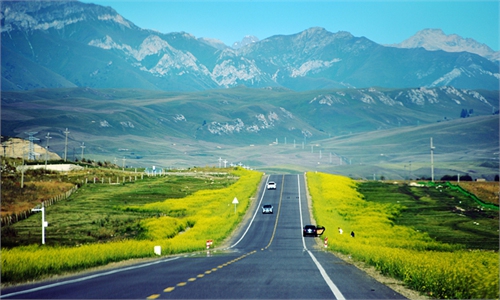
Illustration: Chen Xia/Global Times
The US' boycott of products from Northwest China's Xinjiang Uygur Autonomous Region aims to contain China's rise and create chaos in the region under the guise of human rights.
However, Xinjiang's outstanding economic development, which is in the interests of people living in the region, will shatter any illusions Washington may have to play the "Xinjiang card."
Xinjiang is currently undergoing a period of intense construction as 70 landmark major projects in the fields of energy, industry, transportation, and water conservancy were launched on Sunday, Xinhua reported.
So far, 400 key projects in Xinjiang have completed a cumulative investment of 136.2 billion yuan ($19.1 billion) this year, an increase of 19 billion yuan compared to the same period in 2022, driving investment growth by 5.6 percentage points, the Xinhua report said.
The investment boom shows that Chinese central government attaches great importance to the socioeconomic development in Xinjiang, and has taken a host of measures to advance prosperity and people's well-being there, while cracking down on the "three evil forces" of terrorism, extremism and separatism in a lawful way to safeguard the national security.
It has to be said that when it comes to cooking up lies about Xinjiang, US politicians are proficient in using the so-called human rights as a tool to attack and smear China; but when Xinjiang registers robust economic growth, these US politicians deliberately avoid these. Why? What are they worried about? What are they afraid of? Concerns have grown with some Western people that Xinjiang's economic development will reveal their own lies and turn their efforts to smear Xinjiang into a joke.
US politicians have fabricated outrageous lies including those surrounding "forced labor," but the previous US move of signing into law the so-called Uyghur Forced Labor Prevention Act, which is designed to curb Xinjiang's economic development, expose its real intention - it is to exclude Xinjiang from the global industrial chain, create economic chaos in Xinjiang, and engender forced unemployment and forced poverty in the region.
Among the US' anti-China tool kit, the "Xinjiang card" has been thrust under the spotlight, but its efforts will be futile in the end. After years of intense crackdowns on the three evil forces, Xinjiang has become more stable, which has greatly contributed to the region's economic development. The introduction of a series of policy measures has made Xinjiang more open, more interconnected and more prosperous. In the first half of 2023, import from and export to Xinjiang reached a total of 149.62 billion yuan, a year-on-year increase of 65.2 percent, according to Xinjiang Daily.
As of March 21 this year, the number of China-Europe freight trains leaving and entering China via the Alashankou Port in Xinjiang has surpassed 30,000, carrying more than 1.35 million Twenty-foot Equivalent Units (TEUs) of goods, according to media reports. Alashankou is China's closest railway port to the EU.
Xinjiang's economic development will be of positive significance to not only ensure and improve the well-being of the people in Xinjiang, but also help to enhance China's economic connectivity with Central Asian and European countries, helping increase the Eurasian connectivity.
The current booming of investment in Xinjiang region is a signal reflecting that China has sped up the construction of major trans-regional passageways. For instance, the railway line between Alashankou and Jinghe in Xinjiang is to have a second track of 70 kilometers, and its construction has entered the track-laying stage, which has been expected to enhance Alashankou port's clearance capabilities. Eurasia's connectivity is improved through the comprehensive improvement of Xinjiang's infrastructure, and it will be conducive to the economic development of the entire Eurasia.
As the joint building of the China-proposed Belt and Road Initiative continues to advance, Xinjiang region is no longer a remote corner but has grown into a hot hub. We are confident that Xinjiang region will become one of the important engines of economic development in Eurasia. With the growing consumer demand of residents in the region and the endogenous driving force of economic development, the US strategy to contain Xinjiang's development is doomed to fail.
The author is a reporter with the Global Times. bizopinion@globaltimes.com.cn



